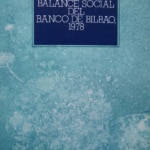A Brief History of BBVA (XXIII): crisis and bank rescues
The 1973 oil crisis, which arose due to the tensions that led to the Yom Kippur War, set off a global chain reaction that also affected Spain. The increase in commodities prices, and a steady decline in Spain’s economic cycle, led to truly difficult times for the banking sector. The upward trend that had begun in the early 1960s was immediately stopped, and worrisome warning signs began to appear, such as an increase in unemployment and a fall in the value of money.

In a Spain experiencing great difficulties due to supply shock and dramatic industrial restructurings, the authorities were forced to adopt restrictive policies. Banks’ liquidity margins narrowed, and there were also significant costs associated with bank forecasting errors. These things, plus the downturn on the stock exchanges, forced many hard-pressed banks to turn to the money market. As if the situation was not complex enough, the industrial sector was suffering a profound crisis since its previous practice was to seek financing from commercial banks. Very low demand in the real economy, falling profits in the industrial sector, great financial expenses accompanied by high debt levels, and bankruptcy-induced hardships left the banking sector in dire straits. As if this were not bad enough, given the situation, banks that served the industrial sector were hit harder than pure commercial banks.
The bank crisis occurred shortly after the State has promoted liberalisation, as we have described in previous chapters, and thus the increase in deposit prices, combined with low demand, undermined bottom lines and, ultimately, banks themselves. Brokerage costs increased due to liberalisation, from 3.45% in 1974 to 4.45% in 1978, and the system became oversized since the number of offices tripled between 1973 and 1983, and the number of employees increased from 155,000 in 1975 to 180,000 in 1980.
In reality, the Spanish bank crisis lasted from 1977 to 1985, although it is often said to have begun on 17 January 1978, the date on which the Bank of Spain – democracy having already arrived – announced that it would take over Banco de Navarra. Fifty-two per cent of Spanish banks were severely affected by the crisis, and their total liabilities amounted to 3.772 trillion pesetas.
Corporación Bancaria, S.A. was created on 1 March 1978 and provided with capital of 500 million pesetas to temporarily keep banks in crisis in business. The Bank of Spain subscribed 50% of Corporación Bancaria’s capital, and the other 50% was subscribed by private banks including Banco de Bilbao, Banco de Vizcaya, Banesto, Banco Central, Banco Hispanoamericano, Banco Pastor, and Banco Popular, as well as smaller banks such as Internacional de Comercio, López Quesada, March, and Mas Sardà. Although the crisis had not yet reached its nadir at the time, Corporación Bancaria ceased to exist in 1981 when it was absorbed by the Deposit Guarantee Fund for Banking Institutions (FOGADE).
Rumasa and Banca Catalana
The darkest years of the banking crisis were 1982 and 1983, with one of the most traumatic events in the sector occurring in this latter year: the Rumasa affair. Those in the banking sector knew that this holding company, which was led by the entrepreneur José María Ruiz-Mateos, was fragile, and they were worried that, if it began to collapse, the banking system would not have the resources to save it. The regulatory authorities and the banking sector were in particular concerned that the holding company’s risks were highly concentrated. Given this, the Bank of Spain attempted to carry out several audits and, upon learning Rumasa might soon become insolvent, informed the Government of its assessment of the situation. The Government then decreed the expropriation of the holding company on 23 February 1983, despite the fact that more questioned the legality of this measure than were convinced by it.

Rumasa expropriation document bbva
Given the complicated nature of this situation, and to prevent the Rumasa banks from being nationalised or sold to foreign entities, as had been the case with Banco Atlántico, fourteen of the most important banks in Spain presented a competitive bid and their acquisition of the Rumasa banks was approved by the Deposit Guarantee Fund.
Banca Catalana had fallen a few months before the Rumasa affair came to light. The Bank of Spain had conducted inspections of Banca Catalana in 1967, 1972, 1974, and 1980 due to various problems and irregularities. Then, in 1982, Banca Catalana was subject to an audit in which it was not able to prove that loans and credits it had granted to real estate companies in which it had invested could be recovered. This, combined with the untrustworthy nature of the information Banca Catalana provided during the audit, led the Deposit Guarantee Fund to take over the bank in November 1982. The Fund then conducted a comprehensive study, which found that Banca Catalana had a deficit of 116 billion pesetas and was in fact bankrupt. This was the second-most serious bank failure in Spanish history, surpassed only by that of the Rumasa Group. Its restructuring, which was led by the Fund, is estimated to have cost at least 100 billion pesetas.
Banco de Bilbao and Banco de Vizcaya
José Ángel Sánchez Asiaín’s great experience and profound knowledge of the banking business allowed him to provide Banco de Bilbao with strong leadership and keep it on the right course during the bank crisis.
However, in addition to expertly managing its finances, he had a strong vision of how to modernise the bank, making it, for example, the first bank in Spain to issue its own credit card, the Tarjeta Banco de Bilbao. Although this card was even initially opposed by some within the bank, who considered the move risky, it was immediately well-received by the market and, over time, became a standard-bearer.
Convinced that everyone should help resolve the economic crisis, Banco de Bilbao also became a pioneer in transparent corporate communication. Under Sánchez Asiaín, the bank imposed greater accountability on itself than did the law at the time, and published a Social Impact Statement, the first by a Spanish bank, and one of the first in the world. This was a demonstration of its intention to open its doors to society.

Cover of Banco de Bilbao’s 1978 Social Impact Statement
At the organisational level, we also note how Banco de Bilbao took advantage of the decision to create the State of Autonomies at the end of the 1970s by undertaking a strong process of regionalisation between 1977 and 1982.
Banco de Bilbao’s stability during the bank crisis allowed it to acquire a number of banks that had been taken over by the Deposit Guarantee Fund, and, in so doing, increase its importance in the banking sector. In 1979, it acquired Banco de Huesca – although not from the Fund – and then it acquired Banco de Promoción de Negocios in 1982, Banca Mas Sardà in 1983, and, in 1984, five former Rumasa banks: Banco de Extremadura, Banco del Oeste, Banco Latino, Banco de Huelva (a 23.23% share), and Banco Condal (a 38.33% share).
The system of restructuring imposed by the authorities during the years of the bank crisis also allowed a strong Banco de Vizcaya to help rescue banks that had encountered difficulties and been taken over by the Deposit Guarantee Fund. Banco de Vizcaya’s Bancaya Group, which it had been forming over the previous decade, was thus able to experience strong growth.
Its first acquisition was Banco de Crédito Industrial, in 1980. One year later, it acquired Banco Meridional. Then, in 1982, Banco de Vizcaya acquired two additional banks, Banco de Préstamo y Ahorro and Banco Occidental. The year in which it made its greatest number of acquisitions was 1984, when it acquired Banco Industrial del Sur and significant assets of Banca Catalana, which had been taken over by the Deposit Guarantee Fund. These latter assets included Banco Industrial del Mediterráneo, Banco Industrial de Cataluña, and Banco de Barcelona. Finally, also in 1984, as did Banco de Bilbao, it acquired a share of Banco de Huelva – in its case, 12.97%.
The Banca Catalana banks Banco de Vizcaya acquired from the Guarantee Deposit Fund were restructured and became highly profitable, ultimately comprising 30% of Bancaya Group’s consolidated earnings.